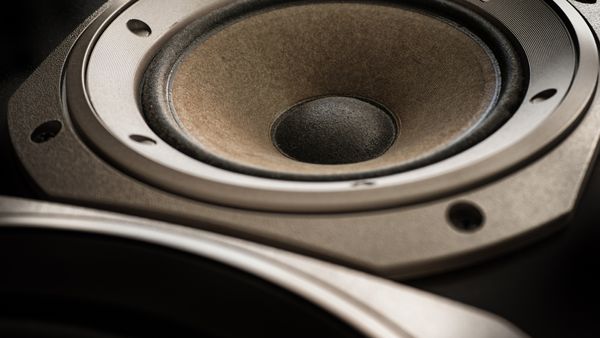Advertisem*nt

One of the most annoying -- but difficult to find and solve -- problems that can crop up in a home theater or stereo system, is a ground-loop subwoofer hum. A ground loop is an electric difference of potential between various ground points throughout the system. Ideally, all ground points have zero volts between them.
When a ground loop problem exists, you'll hear a low frequency hum when you plug any audio or video components -- including subwoofers -- in the electric outlet. This hum is caused by the ground voltage potential differences among the system components, power cords and audio/video cables.
Advertisem*nt
Although some people like trying to stop subwoofer hum by using a power conditioner, in most cases it doesn't help [source: Lofft]. Instead, try the following steps to stop subwoofer hum.
- If the subwoofer is plugged into its own outlet, plug the subwoofer's power cord into an outlet shared by the other components. Use an extension cord if necessary.
- If the hum persists, and your system includes a cable TV, disconnect the cable line. If the hum stops, install an isolation transformer on the cable.
- If the hum persists, disconnect the remaining component cables one at a time until the hum stops. Install a coaxial isolation transformer on that cable.
- If the hum persists, install a line-level ground loop isolator on the subwoofer's line-level feed cable. This usually solves most hum problems.
- If nothing helps, disconnect all the audio cables from the subwoofer. Leave the subwoofer plugged in and switched on. If the subwoofer hums, it points to a defective unit. Contact the company's customer service to technical support [source: PartsExpress]. //]]]]> ]]>
Advertisem*nt
Subwoofer FAQ
How do subwoofers work?
Subwoofers act as loudspeakers that are responsible for amplifying the bass. Low-frequency sounds are enjoyed best on sound systems that have subwoofers as they cause the "boom" of the bass to reverberate.
What is the difference between a subwoofer and a speaker?
Subwoofers and speakers have the same purpose. However, their frequency range differs. Subwoofers are responsible for the bass while speakers are basically electro-acoustic transducers responsible for the amplification of sound.
Is a subwoofer in a car worth it?
It comes down to personal preference, but many people enjoy subwoofers in their vehicle, especially if it’s a “fun” vehicle like a sports car or off-roading vehicle.
What is the best size for a subwoofer?
If you’re someone who loves heavy bass, a 12-inch subwoofer is the perfect choice.
Why does my subwoofer make a humming noise?
The voltage difference between a subwoofer electrical ground and the equipment ground can cause it to hum. This can happen because of the irregular current flow in your audio cable. Turning on the volume too high can also cause a hum.
Cite This!
Please copy/paste the following text to properly cite this HowStuffWorks.com article:
Citation
More Awesome Stuff

Up Next
How Speakers Work
Explore More

You May Like
How Surround Sound Works
Explore More

Keep Reading
Can you connect a subwoofer to an amplifier?
Explore More
Advertisem*nt
Advertisem*nt
Loading...
\n\n\t\t\t\t
`;t.byline_authors_html&&(e+=`By: ${t.byline_authors_html}`),t.byline_authors_html&&t.byline_date_html&&(e+="|"),t.byline_date_html&&(e+=t.byline_date_html);var i=t.body_html.replaceAll('"pt','"pt'+t.id+"_");return e+=`\n\t\t\t\t
\n\t\t\t\t
\n\n\t\t\t\t
${i=i.replaceAll("#pt","#pt"+t.id+"_")}
\n\n\t\t\t
`}(a);this.loadedDiv.innerHTML+=n,document.title=a.title+" | HowStuffWorks";let s="content-loaded-"+a.id,l=document.getElementById(s);l.dataset.contentId=a.id;let o=l.querySelectorAll(".lazyload");HSW.utilities.lazyLoadElements(o),HSW.ux.editorial.init({twitter:!0,facebook:!0,instagram:!0}),l.querySelectorAll(".toc a").forEach(t=>{t.addEventListener("click",t=>{t.preventDefault();let e=t.target.dataset.target,i=document.querySelector("a[name='"+e+"']");i?i.scrollIntoView({behavior:"auto"}):console.error("Unable to locate target with name "+e)})});try{if(userData.adsActive)if(HSW.utilities.isMobile()){l.querySelectorAll(".ad-mobinline").forEach(t=>{t.setAttribute("id","ad-wrap-mobinline"+r),t.childNodes[0].setAttribute("id","ad-div-mobinline"+r),void 0!==HSW.ads&&HSW.pq.add(()=>{HSW.ads.addNewUnits(["ad-div-mobinline"+r])},"ads"),r++})}else{let t=document.createElement("div");t.setAttribute("id","ad-after-"+e),t.classList.add("ad-inline","mb-8","bg-gray","w-max-full","h-min-90","text-center");let a=document.createElement("div");a.setAttribute("id","ad-div-inline"+i),t.appendChild(a),l.after(t),void 0!==HSW.ads&&HSW.pq.add(()=>{HSW.ads.addNewUnits(["ad-div-inline"+i])},"ads")}}catch(t){console.error(t)}if(window.setupSinglePageUX(l),history.pushState)try{history.pushState(null,a.title+" | HowStuffWorks",a.href)}catch(t){console.warn(t)}var c=[];a.taxonomy.forEach((t,e)=>{c[e]=t.title.toLowerCase()});var d=c.join("/"),h=[];a.authors.forEach((t,e)=>{h[e]=t.first_name.toLowerCase()+" "+t.last_name.toLowerCase()});var g=h.join(",");pageMetricsData.href=a.href,pageMetricsData.title=a.title,pageMetricsData.tax=d,pageMetricsData.aType=a.asset_type,pageMetricsData.cType=a.type+"-continuous",pageMetricsData.template=a.template,pageMetricsData.source=a.source,pageMetricsData.sponsor=a.sponsor,pageMetricsData.author=g,pageMetricsData.contentid=a.id,pageMetricsData.image=a.hero_image,pageMetricsData.page=0,pageMetricsData.pubDate=a.publish_date.slice(0,10),pageMetricsData.editDate=a.last_editorial_date.slice(0,10);const u=/[^\da-z_]/i;let p=HSW.utilities.isMobile()?"hsw_lite":"hsw";a.taxonomy.slice(1,3).forEach((t,e)=>{p+="|"+t.title.replace(u,"").toLowerCase()}),pageMetricsData.adUnit=p,Alpine.store("share",{title:pageMetricsData.title,url:pageMetricsData.href,image:pageMetricsData.image}),function(t,e){let i=t.href.split(".com/").pop();dataLayer.push({event:"virtual-page-view",virtualPageUrl:i,virtualPageTitle:document.title,pageNbr:0}),dataLayer.push({event:"raw-event-interactive",eventCategory:"page-interaction",eventAction:"continuous-load",eventLabel:"new-content",eventValue:e+1,virtualPageUrl:t.href})}(a,this.items.length);const m={...pageMetricsData};t.items.push(m);for(var f=document.getElementsByClassName("new-content-loaded"),v=0;v
Advertisem*nt
Advertisem*nt
Advertisem*nt
Advertisem*nt
`;function adFill(){return{triggerElement:null,observer:null,isObserverPolyfilled:!1,nextIndex:0,maxIndex:30,disabled:!1,init(e){if("off"===HSW.utilities.hashArgs.ads)return;if("article-structured"==pageMetricsData.cType||HSW.utilities.isMobile()||!1===userData.adsActive)return;const t=this;this.triggerElement=document.querySelector("#continuous-ad-load-trigger"),this.nextIndex=e||this.nextIndex,"IntersectionObserver"in window&&"IntersectionObserverEntry"in window&&"isIntersecting"in window.IntersectionObserverEntry.prototype&&"intersectionRatio"in window.IntersectionObserverEntry.prototype?(this.observer=new IntersectionObserver(function(e){!0===e[0].isIntersecting&&t.getNextAd()},{rootMargin:"1000px 0px",threshold:.01}),this.observer.observe(this.triggerElement)):(this.isObserverPolyfilled=!0,window.alpineInfiniteRRScroll={scrollFunc(){var e=t.triggerElement.getBoundingClientRect();e.top